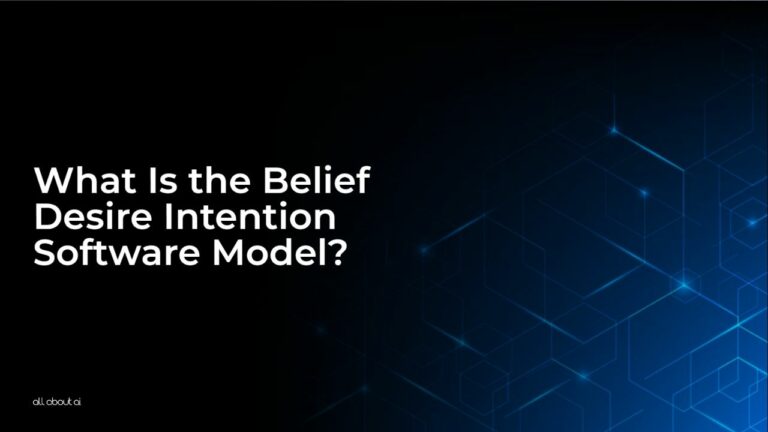The Belief Desire Intention (BDI) software model is a conceptual framework used to design and implement intelligent agents, which can simulate human-like decision-making processes. In essence, the BDI model helps AI systems understand and respond to the beliefs, desires, and intentions of both themselves and other agents, enabling them to make rational and goal-oriented choices.
Looking to learn more about BDI in the context of AI? Read this article written by the seasoned professionals at All About AI.
Examples of Belief Desire Intention Software Model
Autonomous Vehicles: BDI models guide self-driving cars by perceiving their surroundings (beliefs), desiring safe and efficient navigation, and intending actions like braking or changing lanes. This ensures adaptability to dynamic traffic conditions.
Recommendation Systems: In platforms like Netflix, BDI models analyze user behavior (beliefs) to suggest tailored content (desires) and maximize engagement (intentions), creating a personalized user experience.
Healthcare Diagnostics: BDI models aid in diagnosing diseases by analyzing patient data (beliefs), desiring accurate diagnoses (desires), and intending effective treatment plans (intentions), improving healthcare outcomes.
Use Cases of Belief Desire Intention Software Model
Customer Service Chatbots: BDI models enhance chatbots’ ability to understand customer queries (beliefs), aim to resolve issues efficiently (desires), and intend actions like providing information or escalation (intentions), enhancing customer support.
Game AI: BDI models power video game NPCs by perceiving player actions (beliefs), desiring game-related goals (desires), and intending strategies to achieve them (intentions), creating dynamic and challenging gameplay.
Industrial Automation: In manufacturing, BDI models utilize sensor data (beliefs) to optimize production efficiency (desires) through actions like machinery adjustments or resource reallocation (intentions), boosting productivity.
Pros and Cons
Pros
- BDI models enable AI systems to mimic human reasoning, enhancing their ability to make context-aware decisions.
- They are effective for tasks where the agent must pursue specific objectives, making them suitable for a wide range of applications.
- BDI agents can adapt to changing environments and preferences, improving their versatility.
- These models can facilitate communication and cooperation among multiple AI agents and humans, fostering teamwork.
- BDI models provide a clear structure for decision-making, making it easier to debug and understand the AI’s behavior.
Cons
- Implementing BDI models can be intricate, requiring a deep understanding of both AI and the application domain.
- They can be computationally expensive, which might limit their use in resource-constrained environments.
- BDI agents may become too focused on their goals, potentially ignoring important contextual information.
- Traditional BDI models lack the ability to learn from data, which is a limitation in dynamic environments.
FAQs
What does Belief Desire Intention stand for in AI?
Belief Desire Intention in AI refers to a software model used to create intelligent agents capable of making decisions based on their beliefs about the world, their desires, and their intentions to achieve goals.
What is the Belief Desire Intention model of agency?
The Belief Desire Intention model of agency is a conceptual framework used to design AI agents that can understand their environment, set goals, and make rational decisions to achieve those goals by considering their beliefs, desires, and intentions.
Can a Belief Desire Intention Software Model be used in natural language processing tasks?
Yes, BDI models can be applied in natural language processing to enhance language understanding and generation in AI systems. This makes them more effective in tasks such as chatbots and virtual assistants.
How do Belief Desire Intention models differ from traditional rule-based systems?
BDI models are more flexible and adaptable than traditional rule-based systems. They allow AI agents to make decisions based on beliefs, desires, and intentions, while rule-based systems follow predefined, rigid rules without considering context or goals.
Key Takeaways
- The Belief Desire Intention software model is a crucial framework in AI. It enables agents to make rational decisions by considering beliefs, desires, and intentions.
- BDI models find applications in diverse fields, from autonomous vehicles to healthcare diagnostics, enhancing AI systems’ decision-making capabilities.
- Pros of BDI models include human-like decision-making, adaptability, and goal-orientation, while cons encompass complexity, resource intensity, and ethical considerations.
- BDI models can be challenging to implement but offer transparent, goal-oriented decision-making, making them valuable in AI development.
Conclusion
The Belief Desire Intention software model enables AI agents to make rational and goal-oriented decisions. Its applications are vast and continue to expand, from self-driving cars to healthcare diagnostics.
BDI models offer a bridge between AI and human-like decision-making, enhancing adaptability and goal orientation. From autonomous vehicles navigating busy streets to recommendation systems tailoring content to user preferences, these models empower AI systems to understand beliefs, desires, and intentions, ultimately delivering more personalized and effective solutions.
To dig deeper into the world of AI and explore related topics, visit our extensive AI Glossary of Terms.





